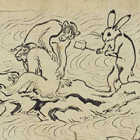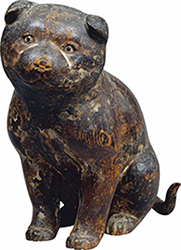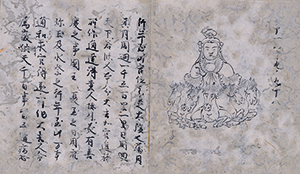展覧会のみどころ
※所蔵表記のないものはすべて京都・高山寺蔵です。
第1章 高山寺伝来の至宝
京都の北西、市内の喧騒から離れた栂尾(とがのお)の地にある高山寺。緑豊かな自然に囲まれたこの古刹は、奈良時代に創建されたと伝わります。鎌倉時代のはじめには、明恵上人が後鳥羽上皇より寺域を賜わり、名を高山寺と号し、その後次第に諸堂が整えられていきました。学問寺として発展してきた高山寺には、貴重な聖教・典籍類とともに、多くの美術作品が伝えられています。
数ある高山寺伝来の美術の中で大きなまとまりをみせているのが、他の寺院から収集・蓄積された白描図像(密教図像)です。こうした白描図像は仏画を描く際の手本となるとともに、新たな教学や仏教思想を生み出す環境を作り出しました。また、魅力あふれる多くの動物彫刻が伝来したことも、高山寺の美術の特徴と言えるでしょう。明恵の周辺で制作されたと考えられるこれらの動物彫刻は、後世、高山寺の国宝・石水院で行なわれた「栂尾開帳」という儀礼で用いられました。
高山寺は、新しい美術や思想が生み出される場であるとともに、様々なジャンルの文物を収集・蓄積し、さらにこれらを後世へと伝える仏教文化の一大拠点として、重要な役割を担い続けてきたのです。
重要文化財 子犬 (こいぬ)
鎌倉時代・13世紀
通期展示
明恵が傍らに置き、愛玩したと伝える木彫の子犬です。明恵の没後は、明恵の坐像を安置する厨子の脇に置かれていたといわれます。頭部をやや傾け、こちらを真っ直ぐ見つめるその仕草は愛嬌たっぷり。動物を愛したという明恵の人柄を偲ばせる作品です。
重要文化財 神鹿 (しんろく)
鎌倉時代・13世紀
通期展示
玉眼が嵌められ、まるで生きているかのような、今にも鳴き出しそうな雌雄一対の鹿の木彫です。鹿は奈良の春日明神の使いで、高山寺では春日、住吉明神を鎮守としました。明恵も春日の神々を深く信仰しており、高山寺における春日信仰を象徴する作品です。
重要文化財 梵天火羅九曜図 (ぼんてんからくようず)
平安時代・文治5年(1189)
展示期間:前期 [4月28日(火)~5月17日(日)]
仏画を描く際の手本ともなった白描図像(密教図像)のひとつで、密教における星に関わる尊像を集めたものです。高野山で密教図像の収集・書写を行った玄証(げんしょう)という画僧の手によるものです。高野山から勧修寺を経て高山寺に伝えられたもので、鳥獣戯画をはじめとする高山寺の文化財がどこからもたらされたのかを考える上でも貴重な作品です。
展覧会のみどころトップへ
第2章 高山寺中興の祖 明恵上人
高山寺を中興した明恵上人は、平安時代末期の承安3年(1173)、紀州有田郡で生まれました。父平重国は武士で、明恵が8歳のときに戦死。間もなく、叔父の上覚について京都・神護寺に入り、名を成弁(後に高弁)と改めます。神護寺では文覚や上覚のもとで真言密教を学び、さらに東大寺で華厳教学を修します。その後紀州有田で10年ほど修行し、高山寺に移りました。高山寺では、求法のため自らに厳しい修行を課すとともに、多くの後進を育て、承久の乱により身寄りを失った女性たちを保護するなど、実践的な宗教活動を行ない、乱世に救いを求める多くの人びとに慕われました。
こうした明恵の生涯は様々なエピソードで彩られています。19歳頃から生涯にわたって夢の記録を残し、多くの和歌を詠み、紀州では、求道のため右耳を切り落とし、釈迦への追慕の念から天竺(今のインド)への渡航を企てました。また、信仰の基盤となった密教と華厳教学を融合した独自の思想を確立するとともに、明恵および明恵を師と仰ぐ人びとによって、彼の思想を反映した美術作品が生み出されました。高山寺、そして明恵ゆかりの美術作品は、数ある日本の仏教美術の中でも極めて個性的で、独自の地平を切り拓いています。
国宝 明恵上人像(樹上坐禅像) (みょうえしょうにんぞう(じゅじょうざぜんぞう))
鎌倉時代・13世紀
展示期間:前期 [4月28日(火)~5月17日(日)]
明恵上人は高山寺の裏山を楞伽山(りょうがせん)と名付け、日々この山中で坐禅を行ないました。上部の賛は明恵自筆の賛です。 画面いっぱいに山景をとり、像主を小さく描くなど、高僧の画像としては異例の作です。画中には明恵を見つめるリスが配され、特定の新来羅漢図からの影響が想定されています。本展では、その範となった「リスを描く羅漢図」もあわせてご紹介します。
国宝 華厳宗祖師絵伝 義湘絵 巻第三(けごんしゅうそしえでん ぎしょうえ)
鎌倉時代・13世紀
展示期間:前期 [4月28日(火)~5月17日(日)]
義湘の渡海を、龍に変じて守護した善妙。女性の献身と救済を、緊迫感ただよう筆さばきで描いています。
国宝 華厳宗祖師絵伝 元暁絵 巻第二(けごんしゅうそしえでん がんぎょうえ)
鎌倉時代・13世紀
展示期間:後期 [5月19日(火)~6月7日(日)]
龍宮を訪れる勅使。ここからもたらされた難解な経典を元暁が読み解き、王妃の病は癒されます。明恵も多くの女性の病を救ったと言われています。
展覧会のみどころトップへ
第3章 国宝・鳥獣戯画
国宝・鳥獣戯画。その名は知らずとも、誰もが一度は目にしたことのある、日本で最も有名な絵巻と言うことができるでしょう。甲・乙・丙・丁の4巻は異なる時代、異なる人物によって描かれたとみられ、その内容もだいぶ異なります。絵を描いた人物も、図像や仏画を描く絵仏師だったとする説、宮廷絵所の絵師だったとする説がありますが、具体的には明らかになっていません。また、詞書がなく、いったい何を目的として描かれたのか、いつの時代に、どこから高山寺へと伝えられたのかも分かっていません。分からないことだらけ。謎多き絵巻です。
ですが、これらの謎を解く一つのヒントが近年明らかになってきました。鳥獣戯画4巻は、朝日新聞文化財団の助成を受けて、平成21年(2009)から4年をかけて解体修理が行なわれましたが、その過程で様々な新事実も確認されました。今後、この絵巻の成立や伝来を紐解く上で重要なポイントとなりそうです。
今回の展覧会では、前後期の展示替により、修理を経て新しく生まれ変わった鳥獣戯画甲・乙・丙・丁の全4巻を展示します。同時に、この4巻から分かれ、国内外に所蔵されることになった断簡5幅も集結。現存する鳥獣戯画のすべてをご覧頂ける機会となります。
国宝 鳥獣人物戯画 (ちょうじゅうじんぶつぎが)
平安時代・12世紀
甲巻
この場面の展示期間:前期 [4月28日(火)~5月17日(日)]
ウサギとサルが水遊び。鼻をつまみダイブするウサギがなんとも愛らしい場面です。
この場面の展示期間:後期 [5月19日(火)~6月7日(日)]
ひっくり返ったカエルに野次馬たちが集まっています。ネコを恐れるネズミの仕草にもご注目。
乙巻
この場面の展示期間:前期 [4月28日(火)~5月17日(日)]
ほえ合うイヌやつかみ合いをするイヌ。様々なイヌの生態が描かれています。
この場面の展示期間:後期 [5月19日(火)~6月7日(日)]
蝶を追う獅子と、後ろ足で頭を掻く獅子。その姿はイヌのようです。
丙巻
この場面の展示期間:後期 [5月19日(火)~6月7日(日)]
風流踊を見物する動物たち。丸まったネコも一心にこれを見つめています。
丁巻
この場面の展示期間:前期 [4月28日(火)~5月17日(日)]
カエルが描かれた本尊を前に法会が営まれます。甲巻の法会の場面をもとに描かれているようです。
展覧会公式ホームページ「鳥獣人物戯画 web絵巻」では、甲・乙・丙・丁の全場面を公開しています。
鳥獣人物戯画の断簡5幅も集結
鳥獣戯画が今日に伝わる過程で、いくつかの場面が分かれ、掛軸に仕立て直されて伝来したものがあります。こうした作品を一般に断簡(だんかん)と呼んでいます。鳥獣戯画は現在、国内外に甲巻の断簡が4幅、丁巻の断簡が1幅確認されており、本展覧会ではこれら全ての断簡もご覧いただけます(一部前期のみの限定展示)。
どの場面がもともとどこから分かれてしまったのかなど、これらの断簡も鳥獣戯画成立の謎を解く重要な要素となります。
鳥獣人物戯画 甲巻 断簡
平安時代・12世紀
東京国立博物館蔵
通期展示
もとは鳥獣戯画 甲巻 第十六紙(上記、甲巻後期展示場面)の前に位置していたとみられる場面です。画面左手の黒点は第十六紙に描かれた萩の花の一部と考えられます。
展覧会のみどころトップへ















